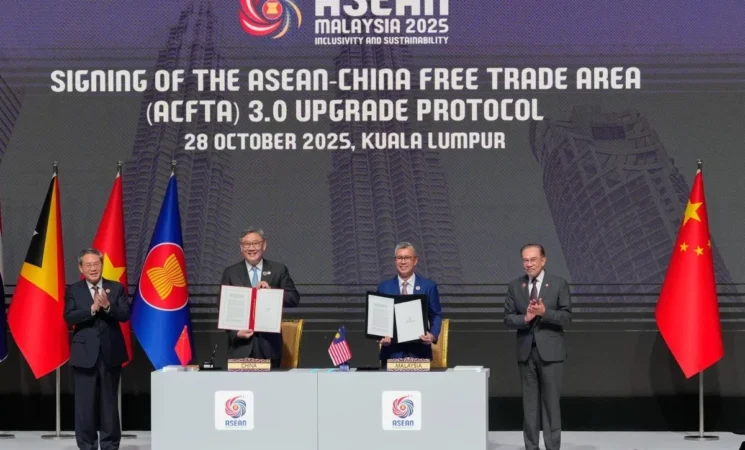3 November 2025, NIICE Commentary 11893
Dr Chander Shekhar
Last month was a pivotal month in the Association of Southeast Asian Nations (ASEAN) and the People’s Republic of China (PRC) relations. On 28 October 2025, both entities bring together the two largest economies by upgrading their Free Trade Area Protocol to a new height by incorporating new emerging sectors. This marks the ASEAN organization's belief in “a major step forward in their economic ties, reflecting a strong, shared commitment to deeper cooperation and regional prosperity”. The step was realized during the 47th ASEAN Summit held under the Malaysian chairmanship with East Timor's induction as its new 11th member. The ACFTA 3.0 would strengthen the ASEAN-China Strategic Partnership in achieving strategic stability in the South China Sea by cementing their non-confrontational areas to manage troubled issues for broader regional prosperity and sends a message to others of its management and inclusive prosperity vision.
ACFTA 3.0: A Strategic Step
China and ASEAN, after several rounds of review, signed an upgraded free trade agreement in October 2025 in the presence of the Chinese Premier and the Prime Minister of Malaysia. Chinese media reports that this comes in the backdrop of their existing bilateral free trade agreements and the Regional Comprehensive Economic Partnership to feature deep expansion in emerging fields, promotion of trade facilitation, and inclusive prosperity for the region. The new compact incorporates emerging domains such as digital connectivity, AI, innovation, green development, and, thereby, it is being described as a model for inclusive growth and prosperity across the global south community.
For the ASEAN countries as well, this endeavour provides a roadmap and strategic competitiveness in the changing times across relevant technological transformation and integrates the regional digital economy. The Xinhua Institute Report claims the cooperation between the two rivals, China and ASEAN, has resulted in “fruitful results and win-win benefits” as part of their Regional Comprehensive Economic Partnership (RCEP) and the Maritime Silk Road Initiative. As the 2024 data shows, the bilateral trade volume between ASEAN and China has grown to 67 %, and it is now 982.34 billion dollars.
However, the ACFTA 3.0 brings not just proximity in regional partners, but also opens the door for vulnerabilities “from industrial decline to compromised economic sovereignty” for the Southeast Asian countries; likewise, the low-cost products coming from China, might affect small and medium-sized industries across the region. Presently, multilateral regimes are under threat from protectionist forces. The global south countries, namely, India, Brazil, South Africa, and others, have stood up in solidarity with like-minded countries. The ACFTA 3.0 reinforces the multilateral mechanism and seeks to inject insulin in the global economy. Media reports say that there might be an opposite result as well, which could give China more power and deepen China’s economic control over the region.
Strengthening Strategic Peace in the South China Sea
Looking beyond a myopic worldview, the new agreement would have its cascading effects on other aspects of ASEAN-China relations. South China Sea is not merely a conflict between the few ASEAN members and China, but also it is a significant concern for all the ASEAN members as a group for regional peace, so to protect their national interests the ASEAN has undertaken such a consensus-based initiative that affects the regional and strategic peace equation in the region.
Often, it is seen minor mutual provocation episodes between claimants in the South China Sea, recently over the Thitu Island between Manila and Beijing. This testing measure for the ASEAN-China Commitment to build a friendly environment in the South China Sea, as enshrined in the Declaration of Conduct, does not affect strategic peace. However, strengthening trade relations has no negative impact, but mutual gains and reinforces their attempts for strategic peace.
Trade can not be studied in a closed room; it has multi-dimensional effects to create grounds for building relations, improving existing fractured ties after tariffs imposition by the United States, and finding opportunities for cementing peace in troubled areas, such as the South China Sea. Annually, trillions of dollars of trade pass through this sea, which often witnesses clashes between coast guards and fishing ships between countries.
Chinese Premier Li Qiang underlined the synergy during the 28th ASEAN-China Summit. He stated that by expanding sectoral areas of cooperation as mentioned above, “ASEAN is willing to do with China for the early conclusion of the Code of Conduct in the South China Sea, and to make positive contributions to peace, security and stability in the region.”
Enhance the ASEAN-China Strategic Partnership for Shared Future
The ASEAN and China relations have seen ups and downs in political and security, economic, and socio-cultural domains. Since they signed the Joint Declaration on Strategic Partnership in 2003, their ties have upgraded to a comprehensive level in the last few years to achieve comprehensive prosperity and development. Trade is an important element and just one part of countries’ bilateral strategic relations. In the ASEAN and China equation, it has become a significant part to enhance their strategic partnership for a shared future.
Chinese leader underlines during the Summit that China and ASEAN ties are set to deepen, yielding fruitful cooperation across fields, bringing benefits to the ASEAN people, which continues to strengthen and set to implement their Comprehensive Strategic Partnership (2026-2030) vision.
Conclusion
The upgraded 3.0 China-ASEAN Free Trade Area is not a reactionary attempt, but evolved over a period of time after several rounds of review. The timing shows the Trump troubled paradox has a minor effect on regional countries. The expansive growth of their ties has a deep impact on their overall strategic partnership to achieve prosperity and peace. The South China Sea peace and prosperity are directly linked with the economies of ASEAN and China's actions.
ASEAN’s elevation in China’s story has expanded in the above-mentioned areas to shape a new reality of the post-Cold War order. As sovereign entities, the durability and long-term peace in the South China Sea precisely lies in their documented response, exploring areas of cooperation, and avoiding creating a mess in alignment with external powers, which Europe undergoing and would take years to come out.
Dr Chander Shekhar is a Researcher at the Center for International Politics, Organizations and Disarmament, Jawaharlal Nehru University, New Delhi, India.

